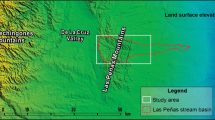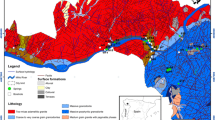Abstract
Water samples collected from dug wells and tube wells from the Kurunegala District of Sri Lanka have been studied for their major hydrogeochemical parameters to understand the chemical quality of water in the terrain. The region is composed of Precambrian metamorphic rocks where groundwater is only available in the regolith and along weak structural discontinuities. The study of the major chemical constituents of groundwater revealed several relationships with the aquifer lithology. Groundwater from mafic rocks have high dissolved solids, while quartzose metaclastic rocks yield water with low dissolved solids. The study area displays very low SO4 2− contents of the groundwater. The chloride content is higher in the dry regions and in terrains underlain by pink granite and marble/calc gneiss while areas with marble, as expected, show high concentrations of Ca and Mg ions. The waters in the region can be classified into non-dominant cations to Na + K dominant and Cl− and HCO3 − dominant types. Water from charnockite-bearing areas tends to have non-dominant cations and more CO3 2− + HCO3 − types. Effects such as soluble salts in the regolith, fracture intensity and climatic variations play a significant role in the behavior of the hydrogeochemistry in the area.









Similar content being viewed by others
References
APHA (1992) Standard methods for the examination of water and wastewater, 18th edn. American Public Health Association, Washington DC
Cleaves ET (1974) Petrologic and chemical investigation of chemical weathering in mafic rocks, eastern piedmont of Maryland. Maryland Geol Surv Report of Investigation, pp 25, 28
Cooray PG (1994) The Precambrian of Sri Lanka: a historical review. Precambrian Res 66:3–18
Corbett RG (1979) Geology and water characteristics. In: Panel on the geochemistry of water in relation to cardiovascular diseases (eds) Geochemistry of water in cardiovascular disease. National Academy of Sciences, Washington, D.C., pp 14–38
Forkasiewicz J, Margat J (1980) Tableav mondial de données nationals déconomie de l’eav, Bureau de Recherches Géologiques et Mineiéres. Département Hydrogéologie 79 SGN 784 HYD, Orleans
Hem JD (1991) Study and interpretation of the chemical characteristics of natural water. Book 2254, 3rd edn. Scientific Publishers, Jodhpur
Intizar H, Thirikawela S, Baker R (2000) Economic Analysis of residential, commercial and industrial uses of water in Sri Lanka, Water International 27(2):183–193
Leo GW, Pavich MJ, Obermeier SF (1977) Mineralogical, chemical and physical properties of the regolith overlying crystalline rocks, Fairfax County, Virginia—a preliminary report. USGS. Open File Report 77–644, p 14
Obermeier SF, Langer WH (1986) Relationships between geology and engineering characteristics of soils and weathered rocks of Fairfax county and vicinity, Virginia. US Geol Surv Prof Paper 1344
Oki T, Kanae S (2006) Global Hydrological Cycles and World Water Resources Science, vol 313, pp 1068–1072
Panabokke CR (1996) Soils and agro-ecological environments of Sri Lanka. NARESA, Colombo, p 220
Tóth J (1999) Groundwater as a geologic agent: An overview of the causes, processes, and manifestations. Hydrogeol J 7:1–14
US Salinity Laboratory Staff (1954) Diagnosis and improvement of saline and alkali soils: US Department of Agriculture Handbook, pp 60, 160
Vörösmarty CJ, Green P, Salisbury J, Lammers RB (2006) Global Water Resources: vulnerability from climate change and population growth. Science 289:284–288
Wallace JS, Gregory PJ (2002) Water resources and their use in the food production. Aquat Sci 64:363–375
Acknowledgments
Ms. Kumudini Adikari of the Water Resources Board of Sri Lanka is mentioned with gratitude, for her support in the chemical analyses. Mr. B. K. Singh of the Central Ground Water Board, India is also mentioned with great respect for his active participation in the groundwater exploration project of the Kurunegala District, Sri Lanka. Thanks go to Ms. Lisel Kopel of the Writing Center of the Oregon State University (ORST) for editing the manuscript. HAHJ acknowledges the support extended by the Biological and Ecological Engineering Department (ORST). RC acknowledges with deep gratitude, the fellowship offered by the Alexander von Humboldt (AvH) Foundation of Germany, which enabled the completion of the research work during his sabbatical leave at the University of Erlangen-Nürnberg.
Author information
Authors and Affiliations
Corresponding author
Rights and permissions
About this article
Cite this article
Jayasena, H.A.H., Chandrajith, R. & Dissanayake, C.B. Hydrogeochemistry of the groundwater flow system in a crystalline terrain: a study from the Kurunegala district, Sri Lanka. Environ Geol 55, 723–730 (2008). https://doi.org/10.1007/s00254-007-1024-z
Received:
Accepted:
Published:
Issue Date:
DOI: https://doi.org/10.1007/s00254-007-1024-z




